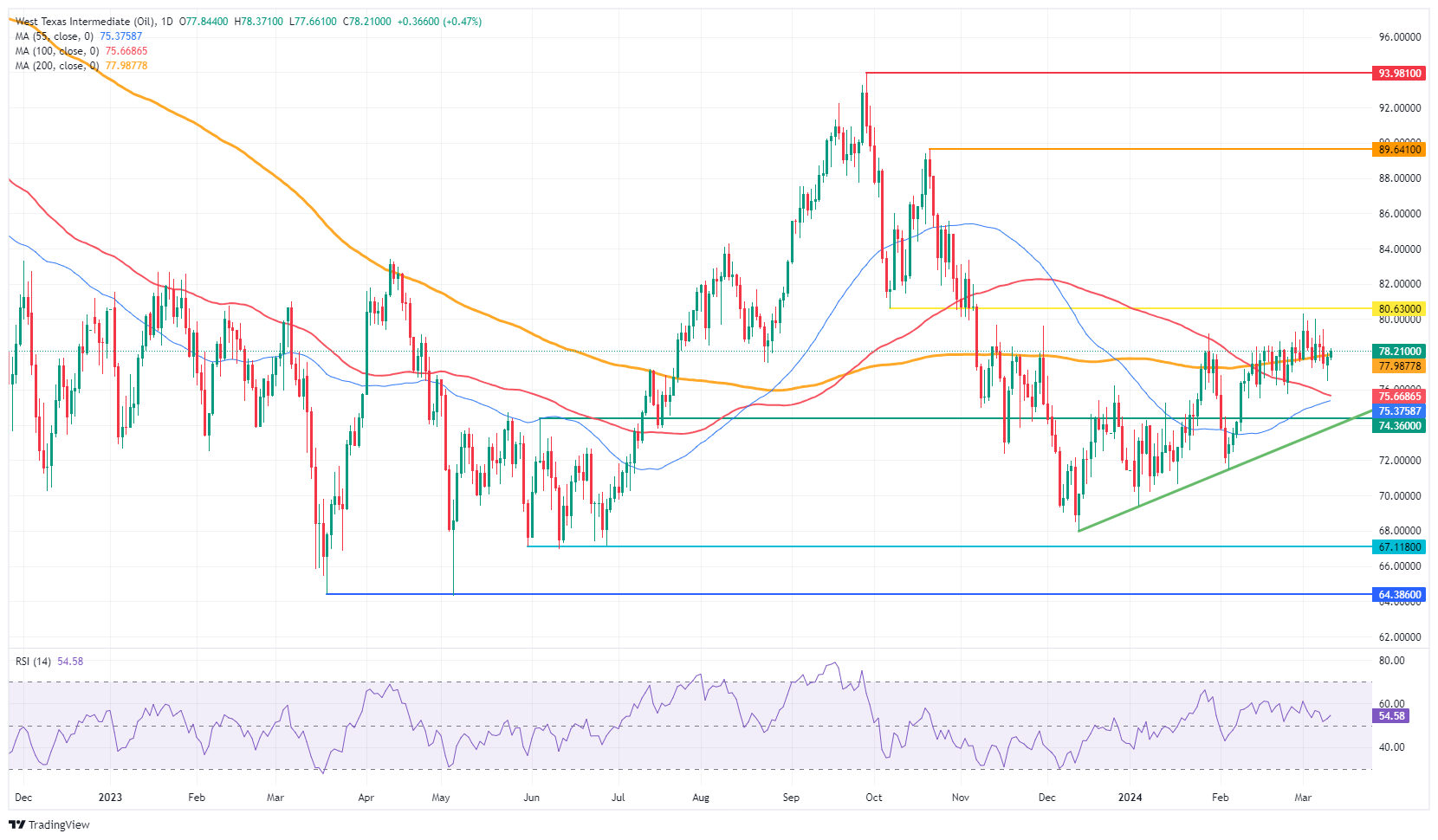- WTI oil falls after disappointing OPEC report.
- Oil traders remain bullish in the short term.
- The Dollar Index trades above 103.00 following the release of the US CPI.
Oil prices are trading sideways after the volatility caused by the publication of OPEC's monthly report. The biggest catalyst in the report pushing crude oil prices into the red this Tuesday comes from Iraq. The country produced many more barrels than the quota agreed upon among OPEC countries, and that for the second consecutive month.
Meanwhile, the Dollar continues to advance on its recovery path and is back above 104.00. This second day of recovery and gains is due to the US Consumer Price Index (CPI) figures, which fell in line with expectations. The markets were already expecting a much greater disinflationary result, although it does not seem that this will be the case. The chances of the US Federal Reserve cutting interest rates are rising again, and the chances of doing so in June or July are now higher.
Crude oil (WTI) is trading at $78.01 per barrel, and Brent at $82.28 per barrel at the time of writing.
Oil news and market movements: dust settles from OPEC report
- Exxon had to stop its production of 188,000 barrels per day at its facilities in Gravenchon, France. The refinery suffered a fire on Monday, which forced the center to stop all its activities.
- Iraq failed to meet its production quota by producing more than 200,000 barrels per day above what was agreed in the OPEC agreement.
- At 20:30 GMT, the American Petroleum Institute (API) will release its weekly crude oil stockpile data for the week of March 8. The previous figure was a small accumulation of 423,000 barrels.
- Russian crude shipments are rebounding to their highest level in more than a year, with most orders heading to Asia.
Oil prices could face a bit of headwind from the OPEC report, although there is nothing really new. Crude oil has already surpassed the 200-day SMA at $77.98 and briefly surpassed the key $78 level. If the OPEC report delivered an encouraging surprise on oil consumption or compliance with current supply cuts, crude oil could rally towards $80 quite easily.
Oil bulls clearly continue to see more upside potential seeing oil futures spreads in favor of bullish bets. However, the break above $80 does not look like it will happen so easily, and $86 appears as the next limit. To the upside, $86.90 follows suit before targeting $89.64 and $90.98 as highs.
On the downside, the 100-day and 55-day SMA are near $75.71 and $75.31, respectively. If we add to this the pivotal level near $75.27, it seems that the downtrend is very limited and well prepared to resist the selling pressure.

US WTI Crude Oil: Daily Chart
WTI Oil FAQ
WTI oil is a type of crude oil that is sold in international markets. WTI stands for West Texas Intermediate, one of the three main types, including Brent and Dubai crude. WTI is also known as “light” and “sweet” for its relatively low gravity and sulfur content, respectively. It is considered a high-quality oil that is easily refined. It is sourced in the United States and distributed through the Cushing facility, considered “the pipeline junction of the world.” It is a benchmark for the oil market and the WTI price is frequently cited in the media.
WTI Oil FAQ
What is WTI oil?
WTI oil is a type of crude oil that is sold in international markets. WTI stands for West Texas Intermediate, one of the three main types that include Brent and Dubai crude. WTI is also known as “light” and “sweet” for its relatively low gravity and sulfur content, respectively. It is considered a high-quality oil that is easily refined. It is sourced in the United States and distributed through the Cushing facility, considered “the pipeline junction of the world.” It is a benchmark for the oil market and the price of WTI is frequently quoted in the media.
What factors determine the price of WTI oil?
Like all assets, supply and demand are the main factors that determine the price of WTI oil. As such, global growth can be a driver of increased demand and vice versa in the case of weak global growth. Political instability, wars and sanctions can alter supply and impact prices. The decisions of OPEC, a group of large oil-producing countries, is another key price factor. The value of the US Dollar influences the price of WTI crude oil, as oil is primarily traded in US dollars, so a weaker Dollar can make oil more affordable and vice versa.
How do inventories influence the price of WTI oil?
Weekly oil inventory reports published by the American Petroleum Institute (API) and the Energy Information Agency (EIA) influence the price of WTI oil. Changes in inventories reflect the fluctuation of supply and demand. If the data shows a decline in inventories, it may indicate an increase in demand, which would drive up the price of oil. An increase in inventories can reflect an increase in supply, which drives down prices. The API report is published every Tuesday and the EIA report the next day. Their results are usually similar, with a difference of 1% between them 75% of the time. EIA data is considered more reliable since it is a government agency.
How does OPEC influence the price of WTI oil?
OPEC (Organization of the Petroleum Exporting Countries) is a group of 13 oil-producing nations that collectively decide member countries' production quotas at biannual meetings. Their decisions often influence WTI oil prices. When OPEC decides to reduce quotas, it can restrict supply and drive up oil prices. When OPEC increases production, the opposite effect occurs. OPEC+ is an expanded group that includes ten other non-OPEC member countries, including Russia.
Source: Fx Street
I am Joshua Winder, a senior-level journalist and editor at World Stock Market. I specialize in covering news related to the stock market and economic trends. With more than 8 years of experience in this field, I have become an expert in financial reporting.







